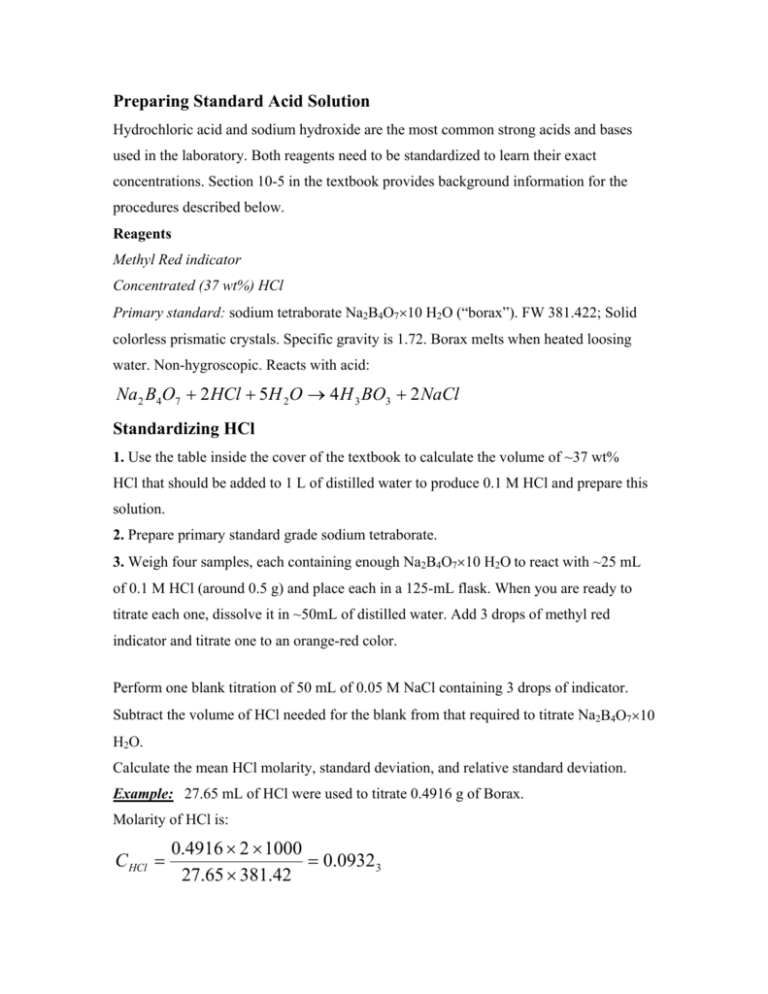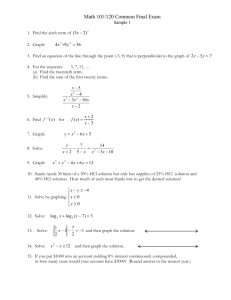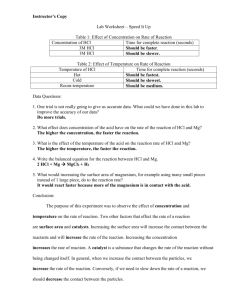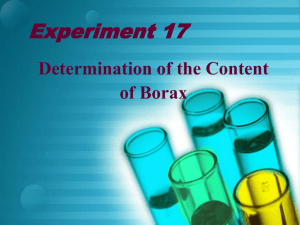Hydrochloric acid and sodium hydroxide are the most common
advertisement

Preparing Standard Acid Solution Hydrochloric acid and sodium hydroxide are the most common strong acids and bases used in the laboratory. Both reagents need to be standardized to learn their exact concentrations. Section 10-5 in the textbook provides background information for the procedures described below. Reagents Methyl Red indicator Concentrated (37 wt%) HCl Primary standard: sodium tetraborate Na2B4O7×10 H2O (“borax”). FW 381.422; Solid colorless prismatic crystals. Specific gravity is 1.72. Borax melts when heated loosing water. Non-hygroscopic. Reacts with acid: Na 2 B4O7 + 2 HCl + 5H 2O → 4 H 3 BO3 + 2 NaCl Standardizing HCl 1. Use the table inside the cover of the textbook to calculate the volume of ~37 wt% HCl that should be added to 1 L of distilled water to produce 0.1 M HCl and prepare this solution. 2. Prepare primary standard grade sodium tetraborate. 3. Weigh four samples, each containing enough Na2B4O7×10 H2O to react with ~25 mL of 0.1 M HCl (around 0.5 g) and place each in a 125-mL flask. When you are ready to titrate each one, dissolve it in ~50mL of distilled water. Add 3 drops of methyl red indicator and titrate one to an orange-red color. Perform one blank titration of 50 mL of 0.05 M NaCl containing 3 drops of indicator. Subtract the volume of HCl needed for the blank from that required to titrate Na2B4O7×10 H2O. Calculate the mean HCl molarity, standard deviation, and relative standard deviation. Example: 27.65 mL of HCl were used to titrate 0.4916 g of Borax. Molarity of HCl is: C HCl = 0.4916 × 2 × 1000 = 0.0932 3 27.65 × 381.42 Using a pH Electrode for an Acid-Base Titration In this experiment you will use a pH electrode to follow the course of an acid-base titration. You will observe how pH changes slowly during most of the reaction and rapidly near the equivalence point. You will compute the first and second derivatives of the titration curve to locate the end point. Analysis of a Mixture of Carbonate and Bicarbonate Obtain the unknown in a clean 250-mL volumetric flask. Dilute to the mark and mix well. Titrate a 25.00-mL aliquot with standard HCl solution. Use the resulting titration curve to select pH suitable for end point detection, and perform triplicate titrations with these. Identify the solute species in the unknown, and report the mass/volume percent of each. Calculate the approximate dissociation constant that can be obtained for any carbonate-containing species from the titration data.










